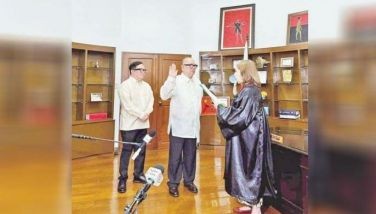The many ‘firsts’ in Phl cinema
Two weeks ago, Funfare featured the “legacy of beauty” of Mang Ador, the founder of the iconic Tropicana Studio which holds the distinction of having photographed celebrities most of them from showbiz. The story and pictures (from the collection of Funfare correspondent Celso de Guzman Caparas) were Funfare’s humble tribute both to Mang Ador and to the Philippine Cinema which is celebrating its 95th anniversary this year (last Sept. 25).
For a follow-up, Funfare asked Celso to compile the many “firsts” in Philippine Cinema. Here are some of them:
• Dalagang Bukid — The first 100 percent-capitalized Tagalog movie starring Honorata “Atang” dela Rama and Marcellano Ilagan (a.k.a. Mar Esmeralda), produced and directed by Don Jose Zialcita Nepomuceno of Malayan Movies, released on Sept. 25, 1919 in Empire Theater after a premiere at Teatro de la Comedia on Sept. 12. Atang was dubbed as “The Queen of Philippine Theater and The First Star of Philippine Cinema.” She was named National Artist for Theater and Music in 1987. Nepomuceno is acknowledged as “The Father of Philippine Cinema.”
• El Hijo Disobediente (The Disobedient Son) — One of the earliest noted films from the Visayan film industry, a 1922 collaboration work of Visayan filmmakers Max Borromeo, Florentino Borromeo and Celestino Rodriguez. Bertoldo Ug Balodoy (1938) was the first Visayan “talkie” movie. Mat Ranillo and Gloria Sevilla, hailed as the King and Queen of Visayan Movies, first appeared as a tandem in Princess Tirana (1951), produced by Azucena Productions.
• Ang Tatlong Hambog — Featured the first screen kiss between vaudeville actress Elizabeth “Dimples” Cooper and sportsman Luis Tuason, produced by Malayan Movies and released on Sept. 28, 1926, in Majestic Theater.
• Ang Aswang — The first “talking” film produced by George Musser of Manila Talkatone Pictures, released on Jan. 1, 1933, in Lyric Theater and Jan. 4, 1933, in Tivoli. The sound was produced by audiographer William Smith at the Manila Talkatone Studio in Pandacan.
• Zamboanga — First screened in the USA before it was released here on Dec. 7, 1937, in Lyric Theater, with Fernando Poe and Rosa del Rosario, and directed by Eduardo de Castro (Marvin Edward de Castro Gardner in real life). The film was entered in Hollywood’s annual Academy Awards that year, rating an honorable mention. It was shot entirely in Zamboanga and Sulu. Hollywood director Frank Capra hailed the film as “the most exciting and beautiful picture of native life I have ever seen.”
• Bituing Marikit — The first offering of Sampaguita Pictures, with Elsa Oria, Rogelio de la Rosa and Ely Ramos, directed by Carlos Vander Tolosa, released on Dec. 27, 1937, in Grand Theater.
• Giliw Ko — Inaugural film of LVN (initials of founders Doña Narcisa Buencamino vda. de Leon a.k.a. Doña Sisang, Carmen Villongco and Eleuterio Navoa), topbilled by Fernando Poe, Reynaldo Dante and Amanding Montes, and directed by Carlos Vander Tolosa. Released on July 29, 1939, in Metropolitan and Aug. 1, 1939, in Grand.
• Ibong Adarna — The first movie with color sequence, hand-painted frame by frame. Produced by LVN, it starred Mila del Sol and Fred Cortez, and directed by Vicente Salumbides. Released on Oct. 17, 1941, in Dalisay Theater.
• Tia Juana — The only movie shown in 1943 when Manila was still under Japanese Occupation. Produced by LVN and directed by Lamberto Avellana, it starred Mila del Sol and Leopoldo Salcedo. Released on May 27, 1943, in Lyric.
• Orasang Ginto — The first post-war movie topbilled by Mila del Sol, Rodrigo “Bimbo” Danao and Domingo Principe, directed by Manuel Conde and produced by LVN. Released on Mar. 4, 1946, in Zest.
• Probinsiyana — The debut film of Dr. Ciriaco Santiago’s Premiere Productions starring Carmen Rosales, Jose Padilla Jr. and Tony Arnaldo, introducing Lilia Dizon and Mari Luisa, written and directed by Susan de Guzman. Released on Aug. 13, 1946, in Dalisay. Months before it was shown, Dr. Santiago conducted a beauty search, Bb. Probinsiyana, in conjunction with the movie: Virginia Palmario of Navotas, Rizal, winner; Lina Buenaventura of Malabon, Rizal, second place.
• Batalyon XIII — The first full-color movie with Carmen Rosales and Jaime de la Rosa, produced by LVN and directed by Manuel Silos. Released on Dec. 16, 1949, in Avenue.
• Dayang-Dayang — The first color film to be processed in the Philippines. Produced by LVN, directed by Nemesio Caravana and released on June 24, 1950, in Life. It starred Mila del Sol and Armando Goyena.
• Never in the film industry’s history that stars from 10 movie outfits have gathered in a grand premiere night. On Feb. 28, 1951, in Life Theater, stars from Sampaguita and those from LVN, Premiere, Lebran, Royal, Nolasco, Balintawak, Benito Bros., Liwayway and Filcudoma came in full force to support tearjerker Roberta with Tessie Agana in the title role. It was Sampaguita’s first film after its studio was gutted by a fire on Jan. 4, 1951.
• Genghis Khan — The first film to be screened at the Venice and Edinburgh International Film Festival in 1952. Released locally in 1950, it starred Manuel Conde, Elvira Reyes, Inday Jalondoni and Jose Villafranca, produced by Manuel Conde Productions. Dubbed in French, the film was screened in France in 1954.
• Maria Clara Awards — the first award-giving body formed by Manila Times Publishing, Co. with its inaugural awards night held in 1951. Major category winners were Doña Sisang, Producer of the Year; Premiere’s Kamay ni Satanas (Best Picture), Gerardo de Leon (Best Director, Kamay ni Satanas), Reynaldo Dante (Best Actor, Kamay ni Satanas), Nena Cardenas (Best Actress, Doble-Cara), Tony Santos (Best Supporting Actor, Hantik), Alicia Vergel (Best Supporting Actress, Mapuputing Kamay) and Mila Nimfa (Best Child Star, Nanay Ko). The second and last Maria Clara Awards were handed out in 1952. Guillermo Tolentino (later named National Artist for Sculpture in 1973) was commissioned to sculpt the statuette that bore the likeness of Maria Clara.
• Rodrigo de Villa — The first Filipino co-production with a foreign film outfit, Indonesia’s Persari Productions, Inc. Produced by LVN, it starred Delia Razon and Mario Montenegro, and directed by Gregorio Fernandez. Released on Aug. 6, 1952, in Dalisay.
• The first FAMAS Awards was held on June 16, 1953 at Rivera Supper Club. Major category winners were: Premiere’s Ang Sawa sa Lumang Simboryo (Best Picture), Gerardo de Leon (Best Director, Bagong Umaga), Ben Perez (Best Actor, Bagong Umaga), Alicia Vergel (Best Actress, Basahang Ginto), Gil de Leon (Best Supporting Actor, Korea) and Nida Blanca (Best Supporting Actress, Korea).
• Luciano Carlos — The first Filipino to win in an international film festival (technical category): Best Screenplay for Ang Asawa Kong Amerikana, the First (1953) Asian Film Festival in Tokyo. Produced by Sampaguita Pictures, with Oscar Moreno, Joan Page and Rudy Francisco, and directed by Enrique Moreno (a.k.a. Eddie Romero), it was released on Jan. 19, 1953, in Life.
• Lilia Dizon — The Filipino to win in an international film festival (acting category): Best Actress for Kandelerong Pilak of LVN at the 1954 Cambodia Film Festival.
• Bahala Na — the first movie filmed in wide-screen with Nida Blanca and Nestor de Villa, produced by LVN and directed by Manuel Conde. Released on Dec. 25, 1956 in Dalisay and Center.
• In 1963, Sampaguita, LVN, Premiere and Lebran studios or collectively known as the Big Four, merged with a group of independent producers and formed the Philippine Motion Picture Producers Association.
• The first Manila Film Festival debuted on June 24, 1966, with 18 entries (14 new and four reissues), a brainchild of then Manila Mayor Antonio Villegas. Cinemasters, Inc.’s Ang Daigdig ng mga Api, starring Barbara Perez and Robert Arevalo, received the first Rajah Soliman Grand Award for Best Picture.
• In 1974, the Movie Workers Welfare Foundation, Inc. (MOWELFUND), a non-stock, non-profit social welfare, educational, and industry development foundation was organized and headed by then San Juan Mayor and president of the Philippine Motion Picture Producers Association (PMPPA) Joseph Estrada for the welfare of workers in the country’s film industry.
• The first Metro Manila Film Festival kicked off on Sept. 21, 1975 with eight entries: Diligin Mo ng Hamog Ang Uhaw na Lupa, JE Productions; Araw-Araw, Gabi-Gabi, Lyra Ventures; Batu-Bato sa Langit, NV Productions; Karugtong Ang Kahapon, Roma Films; Siya’y Umalis, Siya’y Dumating, Mirick Films; Postcards from China, Premiere Productions; Kapitan Kulas, LEA Productions; and Alat, TIIP Productions. Diligin romped away with six major awards including Best Picture, Augusto Buenaventura (Best Director), Best Actor (Joseph Estrada), Best Supporting Actor (Vic Silayan), Best Editing and Best Sound Engineering (Edgardo Vinarao).
• The first Gawad Urian was held on Feb. 21, 1977, at the Little Theater of Cultural Center of the Philippines. Major category winners were: Gerardo de Leon (Natatanging Gawad Urian); Ganito Kami Noon…Paano Kayo Ngayon? (Best Picture); Eddie Romero (Best Director, Ganito…); Vic Silayan (Best Actor, Ligaw ng Bulaklak); Nora Aunor (Best Actress, Tatlong Taong Walang Diyos); Ruel Vernal (Best Supporting Actor, Insiang); and Maya Valdez/Yvonne (tie for Best Supporting Actresss: Lunes, Martes… and Ligaw na Bulaklak).
• The Film Academy of the Philippines was born in 1981, together with the Film Fund, the Film Ratings Board, the Film Archives and 12 industry guilds. The first FAP Awards (named Luna Awards since 2005) was held on Apr. 27, 1983, at the Manila Film Center. Major category winners were: Batch ’81 of MVP Pictures (Best Picture); Romy Suzara (Best Director, Uod at Rosas); Philip Salvador (Best Actor, Cain at Abel); Vilma Santos (Best Actress, Relasyon); Rodolfo “Boy” Garcia (Best Supporting Actor, Ito Ba Ang Ating Mga Anak?); and Liza Lorena (Best Supporting Actress, Oro, Plata, Mata).
(E-mail reactions at [email protected]. You may also send your questions to [email protected]. For more updates, photos and videos visit www.philstar.com/funfare or follow me on www.twitter/therealrickylo.)
- Latest
- Trending
































